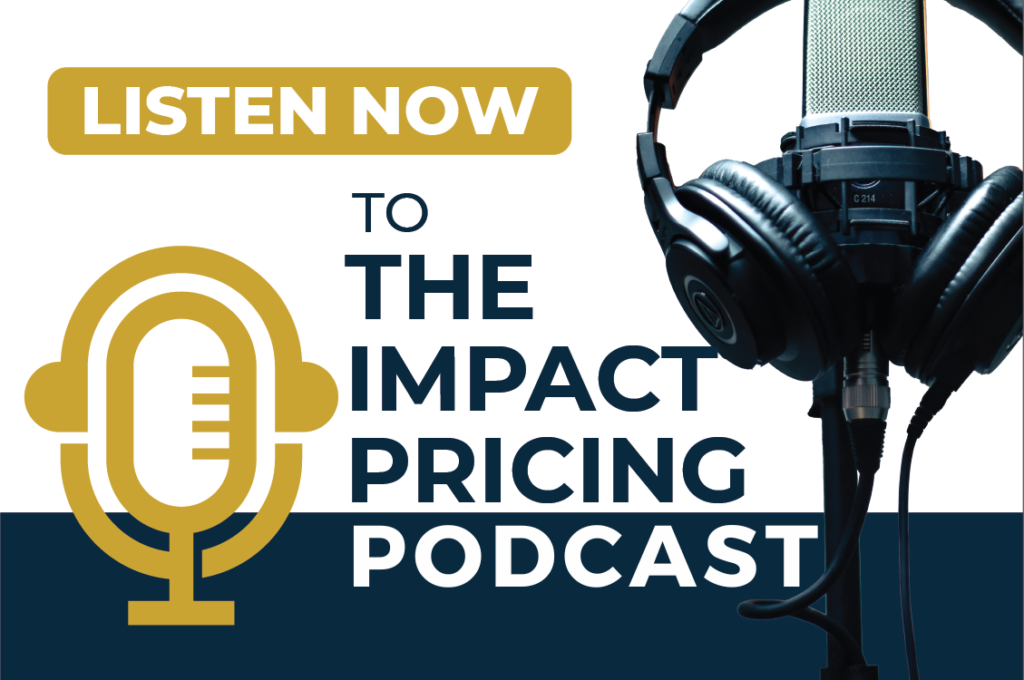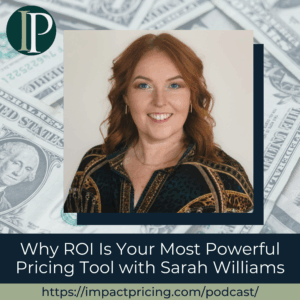Steven Forth has been a frequent guest on Impact Pricing and is a co-creator of the COMPASS framework. Michael Mansard is the Principal Director of Subscription Strategy at Zora. He’s an investor in and mentor to several startups, and he started his career in consulting at companies like Deloitte and SAP, so he knows a lot.
In this episode, Steven and Michael dive deep into the COMPASS framework for evaluating pricing metrics in the age of AI and agentic systems, exploring how traditional SaaS economics are being turned upside down and why companies need to move away from user-based pricing models.
Podcast: Play in new window | Download
Why you have to check out today’s podcast:
- Learn why AI pricing fundamentally breaks the traditional SaaS model of “expensive to build, cheap to run”.
- Understand the COMPASS framework’s 14-question assessment for selecting optimal pricing metrics.
- Explore the accelerating cycles of pricing complexity and simplification across technology waves.
“Most people are clueless and do not want to admit that they’re clueless. Admission is key because admission leads you to a scientific approach to pricing and enables you to accept, to try smaller samples, especially in the age of AI.”
– Michael Mansard
Topics Covered:
02:08 – How Michael got into pricing
03:12 – Defining business models vs. pricing models vs. pricing metrics
06:22 – Introduction to the COMPASS framework and why it exists
07:25 – How AI flips traditional SaaS economics on its head
08:03 – The gym membership paradox in AI pricing
11:05 – Steven’s perspective on whether pricing fundamentals have changed
24:20 – Pricing evolution cycles and their accelerating speed
27:39 – How COMPASS captures competitive differentiation
34:28 – Michael’s pricing advice on embracing iteration and admitting uncertainty
Key Takeaways:
“I’ve seen more change in my part of the technology world in the last six months than I’ve seen in my entire lifetime.” – Steven Forth
“If you price it per user, the more a user uses it, the worse margin it would yield. And that’s a problem, right? So I call that the gym membership paradox.” – Michael Mansard
“We need to change the metric. Now the billion dollar question is what metric? And the raison d’être of that framework is exactly that. It’s to help people navigate, hence the notion of COMPASS.” – Michael Mansard
Resources and People Mentioned:
- COMPASS Framework: 14-question assessment for pricing metrics: https://www.linkedin.com/pulse/compass-agentic-ai-pricing-metric-framework-your-2-part-mansard-f9qqe
- Roger Martin Strategic Choice Cascade: Framework for aligning pricing with business strategy: https://rogermartin.medium.com/decoding-the-strategy-choice-cascade-475d40555eb1
- John Maeda’s “The Laws of Simplicity”: Design principles applicable to pricing models: https://lawsofsimplicity.com/
- Karan Sood: https://www.linkedin.com/in/soodkaran/
- PriceFX: Company introducing 125 agents: https://www.pricefx.com/ and https://lp.pricefx.com/agents_trial.html
Connect with Steven Forth:
- LinkedIn: https://www.linkedin.com/in/stevenforth/
- Email: [email protected]
Connect with Michael Mansard:
Connect with Mark Stiving:
- LinkedIn: https://www.linkedin.com/in/stiving/
- Email: [email protected]
Full Interview Transcript
(Note: This transcript was created with an AI transcription service. Please forgive any transcription or grammatical errors. We probably sounded better in real life.)
Michael Mansard
I think that most people are clueless and do not want to admit that they’re clueless. And I think admission is key because admission leads you to a scientific approach to pricing and enables you to accept, to try smaller samples, especially in the age of AI. And I think those who think they know and don’t try to learn are going to be the ones that are going to lose the battle.
[Intro / Ad]
Mark Stiving
Welcome to Impact Pricing, the podcast where we discuss pricing, value, and the recipe-like relationship between them. I’m Mark Stiving, and I run bootcamps to help companies get paid more. Our guests today are Steven Forth and Michael Mansard.
Here are three things you want to know about Michael, I’d tell you about Steven but he’s been on here about 300 times, before we start. Michael is the Principal Director of Subscription Strategy at Zora. He’s an investor in and mentor to several startups, and he started his career in consulting at companies like Deloitte and SAP, so he knows a lot.
And by the way, Steven has had Michael and I on some webinars, and I just love talking to these two guys. We talk about AI, we just can’t stop talking. So welcome, Michael. Welcome, Steven.
Michael Mansard
Good to be here and thank you.
Steven Forth
I’m happy to be with both of you.
Mark Stiving
Michael, real quickly, how did you get into pricing? Because we always ask that question and we haven’t heard your answer.
Michael Mansard
That’s a great question. I’ve never asked it myself. So I think actually pricing got into me. So my background was very much in finance, while a lot of pricing folks came from marketing of products, working on the actual order to cash. So my background is really around how to optimize subscription offerings and recurring offerings.
And of course, you know, a core topic is pricing, because if you don’t price properly, then the pricing mistake can actually kill your company. So that’s how, you know, I get passionate about pricing.
Mark Stiving
Excellent. Thank you. Thank you. Okay. Let’s start off with a question. I actually told you guys I was going to ask this question and you’re like, well, what’s the answer? And I don’t know. But let’s start off with the following question. What’s the difference between a business model, a pricing model, and a pricing metric?
Are they the exact same thing? Are they actually different? And I also told you that I went and asked Perplexity before I asked you guys this question, but let me just hear your thoughts. I mean, do we use these interchangeably? Do they mean something different? Steven, go ahead. You’re shaking your head like you have an answer.
Steven Forth
Yeah. I think these are nested. So the business model is a larger construct and includes things such as how do we innovate? How do we go to market? What is our larger strategy and our larger positioning? And the pricing model exists to support the business model.
So one of the things that we do when we’re talking to people is we use a Roger Martin strategic choice cascade but we have aligned it with pricing strategy. And one of the first things we do is to say, okay, how does your pricing strategy, how will your pricing strategy align with your larger strategy? So the pricing strategy is one piece of how you execute on a business model.
And then, pricing metric is, I think, fairly straightforward. It’s important to differentiate the value metric and the pricing metric. The value metric is the unit of consumption by which a user gets value. And the pricing metric is the unit of consumption for which a buyer pays. That’s my summary.
Mark Stiving:
Okay. So I might disagree slightly on the value metric definition, but let’s not go there quite yet. And can you give us an example of a pricing metric versus a value metric? No, no, no. I’m sorry. A company that has a business model different than a pricing model, different than a pricing metric.
Steven Forth
So the pricing metric is part of the pricing model, but it’s not the whole thing, but it’s a component in a pricing model.
Mark Stiving
Just like the pricing model is part of the business model.
Steven Forth
Yeah. It’s a subcomponent. So I think the business model, especially today, includes things like how do we innovate? How do we build resilience? And it would be asking a pricing model to do too much work to cover off on all of those things.
Mark Stiving
Okay. So before I push any more, Michael, do you have any thoughts on that?
Michael Mansard
I agree completely with Steven. The way I see it is for a given package, set of features you put on the markets, you actually have a mathematical equation. If I use big words to actually sell it to clients, and that’s the pricing model. The pricing model is one or several metrics to put a price against with a mathematical function.
Is it flat? Is it variable? Is it prepaid? Is it postpaid? And the metric is, or the metrics, by the way, are the means, the unit of measure that you want to use in order to reflect as close as possible the value metric, right? So essentially, it’s the mathematics in the background. It’s the equation that must stick as close as possible to value in a perfect world.
Mark Stiving
Okay. Well, the reason I asked the question and the reason I even thought about it is that we’re going to talk about COMPASS today, right? And COMPASS is Michael’s, what do you want to say, thought child? Would that make sense?
Michael Mansard
I think it does.
Mark Stiving
On how do we evaluate pricing metrics? And so I just started thinking about what does that actually mean? What is a pricing metric and how does it tie to everything else? So let’s jump into talking about COMPASS for a second. And Michael, here’s a softball for you. Why COMPASS and why are all of the letters capitalized? Is it an acronym?
Michael Mansard
So absolutely, it’s an acronym. I have to say, I don’t quite remember exactly what each letter stands for. And you know why? Because actually when I co-created, so I stopped with Steven and we decided, look, we need to create this solution for metrics. It started with Gen AI and Agentic made it like a mandatory move.
And when I created the framework, I was like, I need to create something around the idea of navigation because you need to navigate the pricing metric. And because I wasn’t very creative, I actually used, guess what, CharGPT, and tried to identify what could be a good acronym.
I said something with navigation, something that does A, so I know for a fact, Mark, that the A from COMPASS is agentic. But I would not remember at the top of my name. I have to be honest on this one.
Mark Stiving
That’s okay. It sounds like the way the U.S. government names bills, right? We try to figure out what the acronym is going to be, and then we fill in the words. Exactly. Okay, well, let’s talk about the content of COMPASS. So what is it and why do we care?
Michael Mansard
So if I step back for a second, we’ve discussed that extensively, but the big change with GenAI first and now agentic AI is that it flips on its head the classic economics that we’ve known in SaaS for a while. You know, SaaS essentially is expensive to build, but cheap to run. AI is the exact opposite, right? I’m a bit exaggerating, right?
But let’s say it’s fast, at least to build, but it’s very expensive to run. Each single inference cost has a natural cost to you. That’s why the margins in Gen-AI and in Agent-AI are typically, for now, in the 15 to 20 points lower than SaaS. So what it means, and we’ve discussed that again extensively, is because it’s so expensive.
If you price it per user, the more a user uses it, the worse margin it would yield. And that’s a problem, right? So I call that the gym membership paradox. Why? Because they make money on people not going to the gym. So you would end up making money and margins on people not realizing the value of the tool.
The second point is that the value you can realize through GenAI, and even more so through agentic because of the agency, because of the fact that it’s essentially displacing entire workflows, you have to capture that value. And again, the user is a bad metric to capture value. And why is it a bad metric?
Because in fact, one could claim that if you use agents, you’re going to need less users in the system because the agent does the work. So on one hand, you’re actually going to yield very bad margins. On the other hand, you’re actually going to have less users. So if you choose users to price, you’re shooting yourself in the foot twice each time, right?
So that’s pretty bad. So it’s a forcing function for companies to move away from one of the main pricing paradigms, which has been user, which if you remember, has been existing since the emergence of the PC, right? So this has been like, what, 40, 50 years, we’ve been using users for, I don’t know, 70, 80% of software solutions as an easy proxy for value, and it just doesn’t work for AI anymore. So what’s the solution? We need to change the question, Mark.
We need to change the metric. Now the million or the billion dollar question is what metric? And the raison d’être of that framework is exactly that, right? It’s to help people navigate, hence the notion of COMPASS, to navigate first which metric you should pick or metrics within a spectrum or continuum of value metric typologies.
And then, within that typology, which specific metric does apply to you. Should it be, for example, per resolution? Should it be per hour? Should it be per processing unit? You have to make decisions, and right now, people are clueless. So that’s why the framework exists, if that makes sense.
Mark Stiving
It makes a lot of sense. So first off, I want to summarize what you said in the beginning of your answer. And that was, hey, as we deliver more value to our customers, they pay us less money. Yep. And that’s the opposite of what we should be doing as pricing people. And so that makes all the sense in the world. Here’s what I find fascinating about this topic.
And Steven, I’d love to hear your thoughts on this as well. When we shifted to SaaS, when we got cloud-based SaaS, we suddenly said, look at this, we don’t have to charge per user or we don’t have to charge per license, we could charge per anything. And so we see companies like Google doing per click or Dropbox doing per terabyte or right.
And so, we get these pricing metrics and we and pricing have been thinking about these pricing metrics for quite a while. And yet all of a sudden AI comes out and it’s like, well, now we have to rethink it. And it feels like we’ve been thinking about it all the time. Did anything change, Steven?
Steven Forth
So, I think, yes, this is part of the ongoing debate that we’re having. So have the fundamentals changed? No. And as Michael said earlier, we’re actually going back to some of the pricing metrics that we used when mainframes dominated computing. But I think what we’re also seeing is far more diversity of pricing metrics. And actually, I’m going to take a step back.
I think what we’re actually seeing is more diversity in value metrics. And this is one of the reasons why we are seeing this surge in credit based pricing. It’s not the only reason. The other reason is because people are able to equate credits with tokens and better manage their costs. But really we’re in early stage innovation here.
New ways of creating value are popping up all the time. Vibe coding. When was the term vibe coding coined? If I’m right, it was in February of this year. And it’s up and good and is upending many business models. And I think it will upend the pricing model, how we do pricing.
Karan Sood had a LinkedIn post recently on vibe pricing. I’m not exactly sure what he means by vibe pricing. I have to ask him that. But things are really changing. I think at a fundamental level, this is a new model of computing. It’s a new model of programming. It’s a new model of how one creates applications, how one packages functionality.
And I think it’s going to drive a real tectonic shift. in how we execute pricing, maybe not think about it. I mean, it’s hard, Mark, it’s hard to push back on your comment that we’ve been thinking about this stuff for a long time and we’re still thinking about it. So what’s really changed, but you know, a change in magnitude, if big enough, can cause a qualitative change.
Can I just drop in one idea here around COMPASS though, because I’ve got another use case for COMPASS that I think is a little bit different from the one that Michael has been talking about.
Mark Stiving
Go ahead, please.
Steven Forth
Yeah. So, I’ve been doing a lot of work over the last few weeks on building taxonomies and classifying different pricing models. And one of the ways that I’m thinking about using COMPASS is as a way, you know, is a new lens into how to classify pricing models.
And if you think of the impact that Linnaean taxonomy had on biology and how Darwin and people were able to understand evolution, having a really good classification system for pricing models is I think absolutely critical as we think about how they’re going to evolve and change. And I don’t think we have one. And I think COMPASS might be part of a step towards that.
Mark Stiving
Hmm. Interesting. Interesting.
Michael Mansard
On a side note, Steven, on this one, that was one of the reasons. It’s because I heard a lot of people using the word outcome or the word output without having a proper definition. And that, that means big problems because if you use the wrong word for the wrong reasons, it has different meanings in people’s minds.
And you cannot drive educated discussions with boards when you talk about an outcome-based metric, what you are really monetizing is an activity. Sorry for interrupting Mark, but Steven, that’s the important point.
Mark Stiving
Yeah, and so if I were to – I mean, I always come back to the fact that, look, pricing fundamentals haven’t changed. It’s the same that we’ve always been thinking about. But it feels to me like what’s really changing in AI is we’ve put this new capability in there where it’s really, really hard for us to figure out what’s the value we’re actually delivering.
Because we can deliver so many broad levels of value, so many different pieces of value, that it’s hard to say, here’s what the value metric looks like, or here’s what the outcome looks like. And so I think we do come back to things like tokens and costs in a lot of cases because, I don’t know if you’ve heard me talk about platforms versus solutions, right?
And so, it feels to me like here we are, we’ve got this platform because it does so many different things. And so we’re going to end up pricing it down to costs because that’s what competition is going to do. Whereas if we can deliver solutions where we can quantify value for specific things, now we can actually price it based on value again. I’m pausing. Go ahead, Steven.
Steven Forth
Yeah. This brings up what we were talking about, I think before we started recording, you know, price FX introducing 125 agents. something I think we need to dig into and explore at a later date. But if you have 125 agents, do they each have different pricing metrics? That sounds crazy making. Do they each have different value metrics?
Are there that many real value metrics? How do these agents get grouped or will they be grouped and packaged? I don’t know. I hope price FX knows, but yeah, I think we’re shifting into a quite a different world and the speed at which things are moving is just. You know, crazy making. I’ve been telling people I’ve seen more change in my part of the technology world in the last six months than I’ve seen in my entire lifetime.
And I’ve been through the first use of the internet and email, the walled garden period, the introduction of the worldwide web and browsers, the tech boom, the tech wreck, the shift to subscription, the financial crisis, and so on and so forth. I have lots of scars, but I’ve seen more change in the last six months than I could have imagined in December.
Mark Stiving
So Michael, I’m going to ask you a really hard question. Ready? Steven and I already know we disagree on something. So before we disagree, what is a value metric?
Michael Mansard
For me, a value metric is the way through which you realize the value that’s being generated and use it as a proxy in order to articulate that value and see how it grows, or don’t grow. So, for example, if I want to, let’s say, articulate the value in the world of real estate, maybe a value metric for a specific persona was going to be an asset manager.
They care about assets and their management for a specific problem. And we’re going to see how that problem ties into impacting that specific metric. And then I would have a pricing metric. that could be the same as the actual value metric. And I’m going to try to tie them both in order to optimize the value discussion and the value capture.
So, I don’t know, Steven, Mark, if I actually make you agree, disagree, if I actually add the third path, which makes you both disagree. But that’s how I see it. So for me, when I build a business case, actually create value drivers and the value drivers actually are linked to some sort of a value metric. So I don’t know if Steven, if you have the same definition or a different one, but that’s how I see the world. But I’m not an expert on that taxonomy specifically.
Mark Stiving
It’s ok. Steven, how did you define it in the beginning? Because it wasn’t exactly what I think, I mean, it wasn’t horrible, of course, because you’re brilliant.
Steven Forth
I think that the critical thing here is really to differentiate between the value metric and the pricing metric. So that to me is what’s really important. And without naming them, there are some consultants and pricing people that confuse the two. So to me, the critical distinction here is that the value metric is not identical to the pricing metric, that the value metric comes first and that the value metric should shape and influence the pricing metric.
Now, how you do that is I think part of the art of how you design pricing models and there are different ways to do it. But the differentiation between the two are critical. So, my sort of rote definition of the two are that value is the unit of consumption by which a user gets value. That’s the value metric. And the pricing metric is the unit of consumption for which a buyer pays.
Mark Stiving
I think the only thing I disagree with that definition, Steven, is the word unit of consumption, right? I think everything else I would agree with completely. I think of a value metric as what is the KPI my customer expects to move when they buy and use my product. And so they may not be consuming, let’s go to assets under management, right?
So they may not be consuming anything that has to do with assets under management, but my goal is to help you increase your assets under management. So that’s the KPI that they’re using. And so I think of that as the value metric. They’re gonna say, Mark, you did a great job because you helped us improve our assets under management. Great, you added value.
Steven Forth
So I think that there are many different ways that one can define value. In Ibaka’s approach, we have a first tier taxonomy of six types of value drivers, and then one can unfold that into a sort of second tier of the taxonomy, which we keep private because we use that a lot in our AIs now. So I don’t think there’s a disagreement.
And I think your point about consumption is true in some cases. Let’s take cybersecurity as an example. I was just talking to a company about cybersecurity pricing. And the reason cybersecurity pricing can be difficult is because you are pricing or the value is what does not happen. And it’s always difficult, right, to communicate, to estimate and to price value.
That’s what insurance companies are quite good at, though. But it’s almost the inverse anyway. So I take your point on consumption. I think value comes in many different forms. Not all of which are economic and not all of which can be reduced into pricing. So I don’t think we’re that far apart, Mark, on this particular point. There are other points in which we are, but.
Mark Stiving
I’m sure we’re not. I’m sure we’re not. I hope we didn’t lose Michael because it looks like he dropped out somehow, but he’ll come back in a second because I was about to ask him the question that I was really curious about on pricing metrics. So I’ll give you the shot to answer it and he can’t hear your answer. How’s that?
Steven Forth
Go for it.
Mark Stiving
So, we go through this whole COMPASS program, and by the way, there’s 14 questions to be able to say, hey, how well does your pricing metric fit this specific situation? And I love those questions. I think they’re brilliant. And as I thought through those, I started to wonder, what does competition have to do with this, right?
Because you guys say, here’s what’s really good for the seller. Here’s what’s really good for the buyer. When is it different? And then I said, well, you know, what really matters is what the buyer wants and what they have access to, right? So if you don’t offer it to me, I can’t get it.
But what I really want is what I want as a buyer. And so, then I try to come up with an example. And the example that I could think of is cell phone usage. So in the old days, we used to pay by the minute of cell phone, and then we paid by the number of texts.
And nowadays, it’s like, here’s my money, give me everything I want. And so the pricing metric changed dramatically, and I would say it changed away from what was good for the seller and what was highly correlated with value to what was good for the buyer, what the buyer wanted. How would you interpret all that?
Steven Forth
Well, I’m not so sure that it changed into something that is not good for the seller because the fact is that their costs dropped dramatically. So, the costs of providing the service dropped to being near negligible compared to the revenues. And basically I would argue that the per minute and per text things were actually cost plus pricing, not even thinly disguised.
Mark Stiving
Wait, wait. Let me push back. By the way, I agree that’s cost-plus pricing, but it’s also correlated with value when you think about the fact that the more phone calls I make, the more value I get, the more I pay.
Steven Forth
Yeah, but also the ability to make phone calls without stressing about the number of minutes you’re consuming is also value. And to bring it back to what you said earlier, the competitive aspect of this is incredibly important, which I fully agree with. And one of the things that we are implementing right now, or we will be implementing next week might be more accurate.
Development does not always move at the pace of ideas, even with vibe coding is to give people the way to take that 14 factor assessment and compare two different pricing plans from a buyer’s perspective and for a specific use case. And I think that will also give rise to all sorts of new insights.
Mark Stiving
Yeah.
Steven Forth
But Michael’s back, so.
Mark Stiving
So, Michael, let me see if I can frame this quickly without repeating everything. And we were simply talking about what is it that drove cell phone companies or cellular companies to go from per minute or per text pricing to all you can eat pricing? And was that because that’s what buyers prefer, even if it’s not necessarily what sellers prefer?
Michael Mansard
I think it’s a matter of cycle. Steven mentioned earlier, you know, the pricing model of the mainframes and the mid frames in the seventies. You know, right now, a lot of people are thinking that what we’re doing with AI pricing is re-innovative. Again, it’s been done in the seventies and what’s really happening, right, is it’s a cycle.
It’s a cycle where we always move from complexification to simplification, and then we’re back to complexification. So what happened with the cell phone, again, is a great example, Mark, because when you look at what we’re doing in software, we’re again going to the cell phone type of models.
So I wouldn’t be surprised that as things get commoditized, we’re going to move into much simpler plans, all you can eat because cost will be under control. And there’s going to be the next wave of AI, and we’ll go back to complexification. So I think it’s just a classic cycle. And there’s really three things, right? There’s complexification, simplification of pricing.
There’s centralization, decentralization and packaging, simple or multiple packaging. And we’re always playing with those different things. And I would say the silver lining is the fact that you actually get more competition. It’s not looking the same. And then, you know, people want something simple, cheaper, and it will go back to the next wave.
So I think it’s something that repeats itself. And we tend to actually forget that it was like that in the past. And then we’ll come the next wave and we’ll forget that it was like that before. So what changes, I think, the dramatic change which you asked before, is it new what we’re living? I think it’s not new. What changes is the magnitude, but it’s the speed.
And I think, Steven, you explained it. And I think now the speed at which the cycles happen is going to be much faster. So maybe next time we’ll remember that actually, you know, it was like that. Because the cycle, when you look at mainframe, it was roughly a 30-year cycle when we moved from mainframe to personal computers.
Then it was a 20 cycle when we moved to internet and cloud. Then the usage-based model, you know, when we moved from flat subscriptions to consumption was 10 years. AI was five years. So probably the next wave would be 2.5 years, right? So it seems that the change now is the magnitude and the speed. I don’t know if you’d agree with that, but it’s just rewriting itself.
Mark Stiving
Okay, so I can certainly agree that it’s moving faster, that it, you know, it’s the cycle that’s shrinking. I think that makes sense. But I like to understand why the cycle even exists. Right, so what is it that’s different about the beginning of the cycle versus the end of the cycle?
And it feels to me like you said, and I think you agreed with this, and that is that it’s competition that is saying, hey, we figured out how to simplify the packaging. We figured out how to simplify the offering or the pricing. Drop the costs. And so we can drop the costs overall. And so we can drive this to something that’s easier for buyers that buyers prefer.
Okay, so let’s say that we all agree with that. Steven may not, but let’s say we all agree with that. How does COMPASS capture that concept, right? Is COMPASS capturing today’s situation or is it capturing what buyers are going to want tomorrow? And as a competitor, I want to be tomorrow’s provider, not today’s provider.
Michael Mansard
It’s an excellent question. So, Mark, on this one, I have a much more accurate answer than what the letters stand for. Trust me. So first. If I just step back for a second, what is interesting is I would define COMPASS as an evergreen framework. I cannot store for the future, but at least from the past, meaning that you could actually review past pricing decisions in light of COMPASS.
And answering precisely your question, in the COMPASS framework, you do have several questions that you have to score. There’s in fact two things in the framework. The first part is that you actually have to decide in which type of metric typology you should play. So that, you know, is not related to your question, but that’s the first thing you do.
Then the second thing you do is within that metric typology, you have to go through 14 feature questions. And some of these questions, and that’s where I thank Steven because he’s been working with me on that by the way, so thanks Steven. We decided to actually put the seller lens but also the buyer lens.
So, by actually going through the question through the dual lens, first it helps you make sure that it creates positive differentiation across the different questions. And moreover there are questions around is this a positive differentiation vis-a-vis competition. So there’s different questions that are going to help you score.
So, by using the score, and of course that’s what you also have to do on that continuous basis, you will always make sure that your pricing metric and model, by the way. And again, thank you, Steven, because I thought that COMPASS was for the pricing metric. And Steven asked me to step back and say, listen, the framework does work for, in fact, assessing the entire model, not just the metric.
So, by going through the 14 feat check question, Mark, at a given time, that’s why you have to revisit the framework continuously, it helps you make sure that you have positive differentiation and that you’re still relevant. So it’s a living creature. So the framework helps you always reassess and not just from your own me, myself and I perspective, but also vis-a-vis the audio customer profiles that you serve.
Mark Stiving
Yeah. Steven, anything to add to that?
Steven Forth
I want to go back to the sort of beginning of your question, Mark, which is why does this happen? Why do we have this start simple, get complex and get simple again cycle. And I think this is deeply ingrained into the nature of evolutionary systems and technology is an evolutionary system and pricing is part of that evolution.
So if you think of Steven Jay Gould’s concept of punctuated equilibrium, where you have sort of a start simple, then you get a proliferation of different designs, and then there’s a die off back to simplicity and then a proliferation and a die off. This is, I think, intrinsic to the nature of innovation, evolution, and pricing is part of that.
I’m going to say this because we’re all pricing geeks here, but pricing is actually one of the central manifestations of the nature of a technology. How you price it is actually a very central part of the DNA of any commercially successful technology. So of course we’re going to see this cycle. And I completely agree with the drive towards simplification as being a really critical thing.
There is a guy called John Maeda. You guys may know he’s a big shot in the design world, but he has a wonderful book called, I think it’s called simplicity. And he has a number of things that you can do to achieve simplicity. And anyone who’s designing pricing or pricing pages or pricing systems should take a look at John Maeda’s book.
And he has a great website that you might want to add into this, Mark, and say, okay, which of these ways of achieving simplicity can I apply to my pricing model? Because one of the key things about pricing models is I think we agree that you want the buyer to be able to understand them. and sales or marketing or your pricing page to be able to execute on them.
And if you get too much complexity, that gets very hard. Remember back in the 1990s, Oracle had an incredibly complex pricing spreadsheet that you had to have a PhD in, in some combination of finance and mathematics in order to understand. And that was actually part of their virtue as far as Oracle was concerned is that they were hard to understand.
Therefore the buyer had to take Oracle’s word on what the price should be. I hope we never go back to that. And I think with AI, we now have tools that we can use to better look into things, to understand them and understand there are black hat pricers who use pricing models to try to trick people into buying things they shouldn’t buy.
Or paying for them in ways that they shouldn’t pay for them. And I’m hoping that AI will. will be a lens that allows us to see through that when it’s happening. Then that COMPASS becomes a framework that will let us really organize this. I’m starting to meander though. So, shut me up, Mark.
Mark Stiving
It’s okay. That’s okay. Go ahead, Michael.
Michael Mansard
Just wanted to share one last thing. You kind of underlined it and we didn’t take the bait, which is interesting. There’s one last angle which drives simplification, which is procurement. And in fact, just today, I spoke with two different large multinational companies at quite a high level. And both companies, when we discussed the COMPASS framework, guess what?
They said, look, it’s really useful to us as well, because right now we are starting to buy a lot of agents and Gen AI offers, and we’re all over the place. We have no ways to actually compare what’s happening. So in what you’re describing, Mark, I think one thing that drives simplification is the fact that as things commoditize, procurements want to start having visibility.
Because costs are exploding and they have no ways to actually understand why. So I think the last driver is actually procurements willing to consolidate vendors and actually need to have a similar basis to understand which one to keep and which one to get out. And I think that’s really important as well as a forcing function for simplification as technology matures.
Mark Stiving
Again, if we were to take a step back, I would argue that essentially what they’re saying is, I want to pay the least amount of money for the most amount of value.
Michael Mansard
Exactly.
Mark Stiving
Now, how do I figure that out?
Michael Mansard
Hundred percent.
Steven Forth
Which is their job.
Mark Stiving
Yeah, that’s their job. That’s their job. So guys, we are already over time and I think we could go for another hour without pausing, but let’s go ahead and wrap this up. Steven, I’ve asked this question a few million times, so I’m going to let Michael answer this question.
Michael, what is one piece of pricing advice you would give our listeners that you think could have a big impact on their business?
Michael Mansard
I would say, right now, not to fear mistakes and iteration. I think that most people are clueless and do not want to admit that they’re clueless. And I think admission is key because admission leads you to a scientific approach to pricing and enables you to accept, to try smaller samples, especially in the age of AI.
And I think those who think they know and don’t try to learn are going to be the ones that are going to lose the battle. because you’re going to have to iterate at an extreme speed and be humble and really focused on the client.
And to Steven’s point, trying to put tricks on your clients to attract money where you shouldn’t be extracting money is going to be a fatal sin. So, I would say, being humble and being open to iteration to have a scientific approach to pricing is more central than ever.
Mark Stiving
Excellent answer. I think we’ve got to keep trying things. None of us know what’s going on yet. So we just have to keep trying. I mean, Steven might, but the rest of us don’t.
Steven Forth
If things make sense to you today, you need help.
Michael Mansard
Yes.
Mark Stiving
To our listeners, thank you so much for your time today. If you enjoyed this, would you please leave us a rating and a review? Steven, we know how to contact you on LinkedIn. Michael, if someone wants to contact you, how can they do that?
Michael Mansard
I love LinkedIn. So, please connect, please share. I would say that’s the best way, through LinkedIn. Yeah.
Mark Stiving
Excellent. He’s very active on LinkedIn as well, I can tell you that. And so, finally, if you have any questions or comments about the podcast, or if your company wants to get paid more for the value you deliver, please email me, [email protected]. Now, go make an impact.
[Ad / Outro]

















